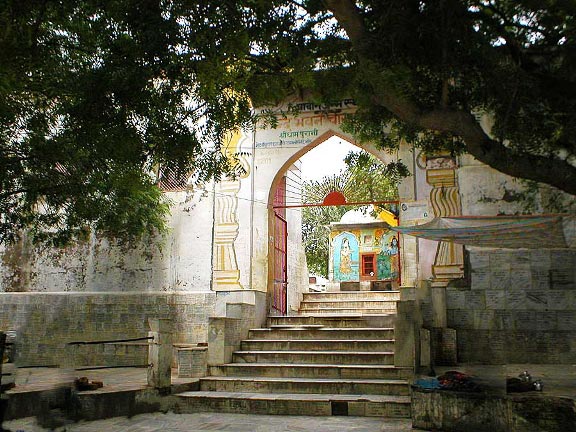
Nanda Bhavan
0 likes
Vraj Mandal Parikarma – by Rajshekhar Das Brahmacari
Situated on top of a small hill known as Nanda Tila, is the famous Chaurasi Khambha,
which is said to have been built by the celestial engineer Vishvakarma for the benefit of Krishna’s
father Nanda Maharaja, the king of the cowherd men. The name ‘Chaurasi Kambha’ means
‘eighty four pillars’ and this kind of building, besides being an opulent status symbol with its
intricately carved stone pillars, was generally used as a durbar or assembly hall, where the king
would meet his ministers and subjects. This is the most important archeological remains of
Krishna’s childhood pastimes at Gokula and is also known as the Nanda ·Bhavan, and it would
have been an important part of Nanda’s palace complex. The word bhavan generally means alarge palatial residence or place for guests and visitors. A great festival to celebrate Krishna’s birth
was held at Nanda Bhavan where Nanda Maharaja freely distributed immense wealth and thousands
of cows to the brahmanas.
Buildings or pillars made from solid rock are almost indestructible and can survive the
ravages of time just the same as natural rocks, which could last even millions of years. The
Chaurasi Khambha is now used as a temple containing the deity of baby Krishna lying in a
swinging cradle, with the deities of Nanda and Yashoda standing behind with Balarama inbetween
them. In the courtyard there is an ancient pipal tree or asvata-vriksa, which is believed
to be a wish-fulfilling kalpavriksha tree. This unusual tree is said to produces five different
colored flowers or blossoms during the year and is said to have been here since Krishna’s time.
There are a number of other shrines in the courtyard including one dedicated to Lord Balarama.
This is the site near Yasoda Bhavan where it is said Nanda Maharaja and his brothers
had their private residential quarters. The word ‘haveli’ means a ‘large residence’ with many
rooms where a number of generations belonging to the same family live together, in what is
generally termed as a ‘joint family’. Therefore, ‘Nanda ki Haveli’ means ‘Nanda’s House’.
which is said to have been built by the celestial engineer Vishvakarma for the benefit of Krishna’s
father Nanda Maharaja, the king of the cowherd men. The name ‘Chaurasi Kambha’ means
‘eighty four pillars’ and this kind of building, besides being an opulent status symbol with its
intricately carved stone pillars, was generally used as a durbar or assembly hall, where the king
would meet his ministers and subjects. This is the most important archeological remains of
Krishna’s childhood pastimes at Gokula and is also known as the Nanda ·Bhavan, and it would
have been an important part of Nanda’s palace complex. The word bhavan generally means alarge palatial residence or place for guests and visitors. A great festival to celebrate Krishna’s birth
was held at Nanda Bhavan where Nanda Maharaja freely distributed immense wealth and thousands
of cows to the brahmanas.
Buildings or pillars made from solid rock are almost indestructible and can survive the
ravages of time just the same as natural rocks, which could last even millions of years. The
Chaurasi Khambha is now used as a temple containing the deity of baby Krishna lying in a
swinging cradle, with the deities of Nanda and Yashoda standing behind with Balarama inbetween
them. In the courtyard there is an ancient pipal tree or asvata-vriksa, which is believed
to be a wish-fulfilling kalpavriksha tree. This unusual tree is said to produces five different
colored flowers or blossoms during the year and is said to have been here since Krishna’s time.
There are a number of other shrines in the courtyard including one dedicated to Lord Balarama.
This is the site near Yasoda Bhavan where it is said Nanda Maharaja and his brothers
had their private residential quarters. The word ‘haveli’ means a ‘large residence’ with many
rooms where a number of generations belonging to the same family live together, in what is
generally termed as a ‘joint family’. Therefore, ‘Nanda ki Haveli’ means ‘Nanda’s House’.
Shri Vraj Mandal Parikarma
The Supreme Lord Çré Kåñëa and Yogamäyä took birth as twins from the womb of Mother Yaçodä in her room in Nanda’s palace. They were born at midnight on Äñöamé (the eighth day after the full moon)in the month of Bhädra when the star (nakñatra) known as Rohiëé was visible in the sky. One can take darçana of Yogamäyä here. Çrémad-Bhägavatam vividly describes how the most fortunate Nanda Bäbä became very joyful upon receiving a son. After the ceremony known as näòécheda-saàskära had been performed, in which the umbilical cord is cut, baby Kåñëa was bathed and so on. Nanda Bäbä then called the brähmaëas to perform the various purificatory rituals and other rites of childbirth.3 Çré Raghupati Upädyäya says: “In a world frightened by birth and death, some people take shelter of the Çrutis, some of the Småtis and some of the Mahäbhärata. But I pay my homage to Çré Nandaräya, in whose courtyard Parabrahma is playing as a child.”
Leave a comment